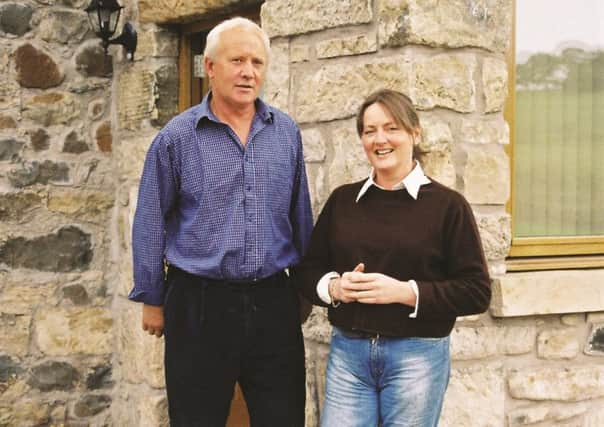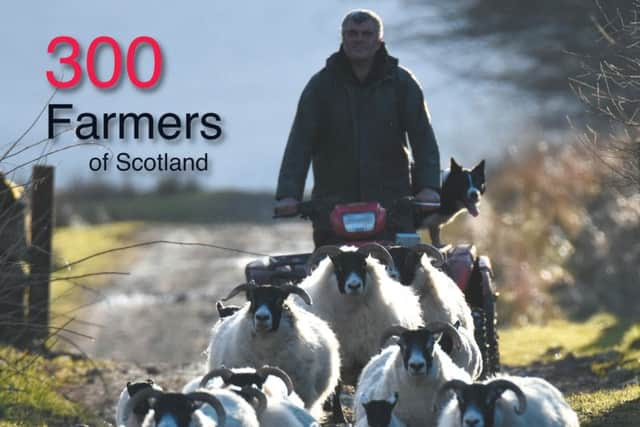Falkirk features in 300 Farmers of Scotland


And it’s that seam Eilidh MacPherson tapped into to create her latest book, 300 Farmers of Scotland.
The editor of a bi-monthly magazine focusing on the farming industry, Eilidh used her contacts to get started on the book.
Advertisement
Hide AdAdvertisement
Hide AdShe personally knew around 80 farmers who are featured and word of mouth helped her discover even more who had stories to tell.


The compilation provides a glimpse of the innovation used by today’s farmers to ensure they not only survive but thrive.
Eilidh said: “I found it really interesting finding out what the farmers are doing differently these days – it was very enjoyable.
“The truth is I’ve only just scratched the surface as there are around 16,000 farmers in Scotland.
Advertisement
Hide AdAdvertisement
Hide Ad“However, I’ve already started on the second instalment and I’m hoping that will be ready in time for Christmas this year.”


300 Farmers of Scotland was released in December and won rave reviews.
And a number of farms in the central belt feature within its 280 glossy pages.
Covering 357,300 hectares and a farmland area of 250,292 hectares the central belt boasts 793 farms of 50 hectares or more.
Advertisement
Hide AdAdvertisement
Hide AdThere are 2519 farms and holdings, including 58 dairy farms, 285 specialist sheep, 237 specialist beef, 113 cereal, 48 specialist poultry and 261 mixed.
Understandably, therefore, it was no mean feat for Eilidh to select the pick of the crop for her book.
Among those featured in this first instalment are John Owen of Muirpark Farm, Carronbridge, Iain MacGillivray and Jacqui Pattinson from Wester Bowhouse, Polmont and the Braes of Burnshot in Blackness.
Each has their own story to tell about farming locally and how it has changed.
Advertisement
Hide AdAdvertisement
Hide AdIt would be fair to say that farming is in John Owen’s blood.
After graduating from Stirling University with an honours degree in ecology, he decided to return to the family farm at Muirpark.
He is now in partnership with his parents at the 1150 acre livestock property at Carronbridge, where cattle and sheep breeding units are to the fore.
With 140 Aberdeen Angus and Limousin cows and 850 Blackface and Blackface cross Texel ewes, John’s not got much spare time.
Advertisement
Hide AdAdvertisement
Hide AdIn the book he admits that his degree is now a “back-up” plan.
He added: “I would like some part time work in that field but time is scarce around here!”
Little wonder, really, as the Owens also run a roadside verge cutting business, with BEAR contracts in Stirling and East Ayrshire.
Time is also precious at the well-positioned Wester Bowhouse Farm in Polmont, which is run by Iain MacGillivray and Jacqui Pattinson.
Advertisement
Hide AdAdvertisement
Hide AdFor as well as looking after 1000 sheep, the couple also run a very successful farm steading guesthouse.
Opened in 2006, thanks to a 50 per cent farm business development scheme grant, within weeks Lismore House had secured a four star grading from VisitScotland.
While Jacqui ensures guests feel welcome, Iain acts as porter as well as tending to the sheep and operating a cattle scanning service across the country.
It’s no less frenetic at Burnshot Farm in Blackness which is renowned for its quality-finished Aberdeen Angus cattle.
Advertisement
Hide AdAdvertisement
Hide AdRobin Braes and his uncle William purchase Angus bullocks, aged over 12 months, from markets all over central Scotland.
William explains the process in the book.
He said: “We buy in from trusted sources; some of the farms we have dealt with for generations.
“If the cattle are right and finish well, we will go back and attempt to buy more – but they are getting harder and harder to find.”
Around 95 per cent of the Braes finished cattle go to Scotbeef.
Advertisement
Hide AdAdvertisement
Hide AdWilliam said: “We also have private butchers who like certain weights of cattle.”
The Braes have been dealing with one butcher shop since 1928 and quite a few also visit Burnshot – as they like to see what the cattle look like on the hoof.
“That is the benefit of dealing direct with the butchers – it makes them comfortable to see what they are buying,” added William.
300 Farmers of Scotland by Eilidh MacPherson is available from local outlets now, priced £25.
Eilidh speaks from experience
Advertisement
Hide AdAdvertisement
Hide AdEilidh MacPherson combines hill sheep farming at Marbrack – between Ayr and Castle Douglas – with her husband Richard Nixon.
Together they farm 2500 acres carrying 1200 Blackface sheep.
Eilidh is also editor of a now bi-monthly publication, Farming Country magazine, which was known as farmingscotland.com when it was free.
Her last book From Thistle to Fern, which was published a decade ago, featured Scots who had emigrated to New Zealand and set up the High Country Sheep Stations.
Advertisement
Hide AdAdvertisement
Hide AdEilidh is a hill sheep and beef farmers’ daughter from the Isle of Skye and headed off overseas once she graduated from Edinburgh in agriculture.
She spent six seasons as a professional sheep shearer, employing Kiwis on Skye, then headed to the Antipodes for the winter.
She managed a lamb group, worked for Scotch Quality Beef and Lamb and then as an independent livestock buyer.
While in New Zealand, Eilidh wrote full time for the New Zealand Farmer for a couple of years – covering Southland and South Otago.
Advertisement
Hide AdAdvertisement
Hide AdShe also freelanced for a number of other titles including High Country Herald, Shearing Magazine, Southland Times and the Otago Southland Farmer.
Farmingscotland.com magazine was launched in September 2003, on her return from overseas – a free monthly title.
It changed its name to Farming Country in 2012 so it could be sold in newsagents and shops across Scotland, Northern England and Northern Ireland.
300 Farmers of Scotland is available now from local outlets, priced £25. Follow Eilidh on Facebook at farmingscotland.com or Twitter @farmingscotland.